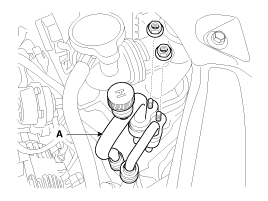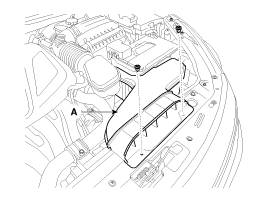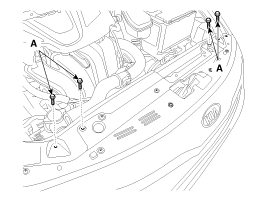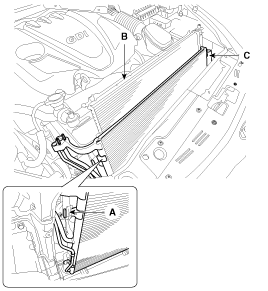Kia Optima Hybrid: Air Conditioning System / Condenser Repair procedures
| Inspection |
| 1. |
Check the condenser fins for clogging and damage. If clogged,
clean them with water, and blow them with compressed air. If bent,
gently bend them using a screwdriver or pliers. |
| 2. |
Check the condenser connections for leakage, and repair or replace it, if required. |
| Replacement |
| 1. |
Recover the refrigerant with a recovery/ recycling/ charging station.
|
| 2. |
Disconnect the negative (-) battery terminal. |
| 3. |
Remove the discharge line and liquid line (A) from the condenser.
|
| 4. |
Disconnect the mounting clip, and then remove the air duct hose assembly (A).
|
| 5. |
Loosen the radiator bracket mounting bolts (A).
|
| 6. |
Remove the radiator fan.
(Refer to EM group - “Radiator”) |
| 7. |
Disconnect the pin (A) and then remove the condenser (C) from radiator (B).
|
| 8. |
Install in the reverse order of removal, and note these items :
|
 Condenser Components and Components Location
Condenser Components and Components Location
Component Location ...
 Receiver-Drier Repair procedures
Receiver-Drier Repair procedures
Replacement 1. Remove the condenser, and then remove the bottom cap (B) with L wrench (A) from the condenser. Tightening torque : 20~25N.m (2.0~2.5kgf.m, 14.5~18.2lb-ft) 2. Remove the desiccant (A) from ...
Other information:
Kia Optima Hybrid (TF HEV) 2016-2020 Service Manual: Front Wiper Motor Repair procedures
Removal 1. Loosen the windshield wiper arm nut (B) after removing a wiper cap (A). 2. Remove the windshield wiper arm and blade (A). 3. If necessary, release the wiper blade fixing clip by pulling up and remove the wiper blade from the inside radius of wiper arm. 4. Disconnect the washer hose (A) connected ...
Kia Optima Hybrid (TF HEV) 2016-2020 Service Manual: Parking Assist Sensor Repair procedures
Removal 1. Disconnect the negative (-) battery terminal. 2. Remove the front/rear bumper. (Refer to Body - "Front Bumper cover") (Refer to Body - "Rear Bumper cover") 3. Disconnect the connector (A) from the sensor. [Front] [Rear] 4. Pull out the sensor (A) by opening the sensor holder (B) out. [Front] ...






